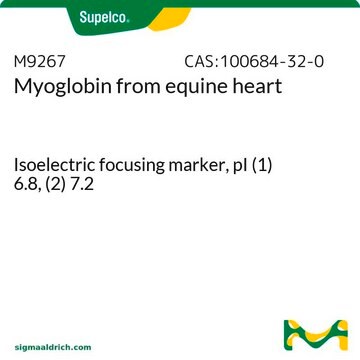C2867
Cytochrome c from equine heart
BioUltra, ≥99% (SDS-PAGE), powder, suitable for mammalian cell culture
Synonym(s):
CYC, CytC, Cytochrome c from horse heart
About This Item
Recommended Products
biological source
horse heart
product line
BioUltra
assay
≥99% (SDS-PAGE)
form
powder
mol wt
12,384
storage condition
(Tightly closed Dry)
technique(s)
cell culture | mammalian: suitable
solubility
water: 10 mg/mL, dark red-brown
UniProt accession no.
storage temp.
−20°C
Gene Information
horse ... CYCS(100053958)
Looking for similar products? Visit Product Comparison Guide
Related Categories
General description
Research area: Apoptosis
Application
Biochem/physiol Actions
Preparation Note
Other Notes
Storage Class
11 - Combustible Solids
wgk_germany
WGK 3
flash_point_f
Not applicable
flash_point_c
Not applicable
ppe
Eyeshields, Gloves, type N95 (US)
Certificates of Analysis (COA)
Search for Certificates of Analysis (COA) by entering the products Lot/Batch Number. Lot and Batch Numbers can be found on a product’s label following the words ‘Lot’ or ‘Batch’.
Already Own This Product?
Find documentation for the products that you have recently purchased in the Document Library.
Customers Also Viewed
Chromatograms
application for HPLCapplication for HPLCapplication for HPLCOur team of scientists has experience in all areas of research including Life Science, Material Science, Chemical Synthesis, Chromatography, Analytical and many others.
Contact Technical Service







